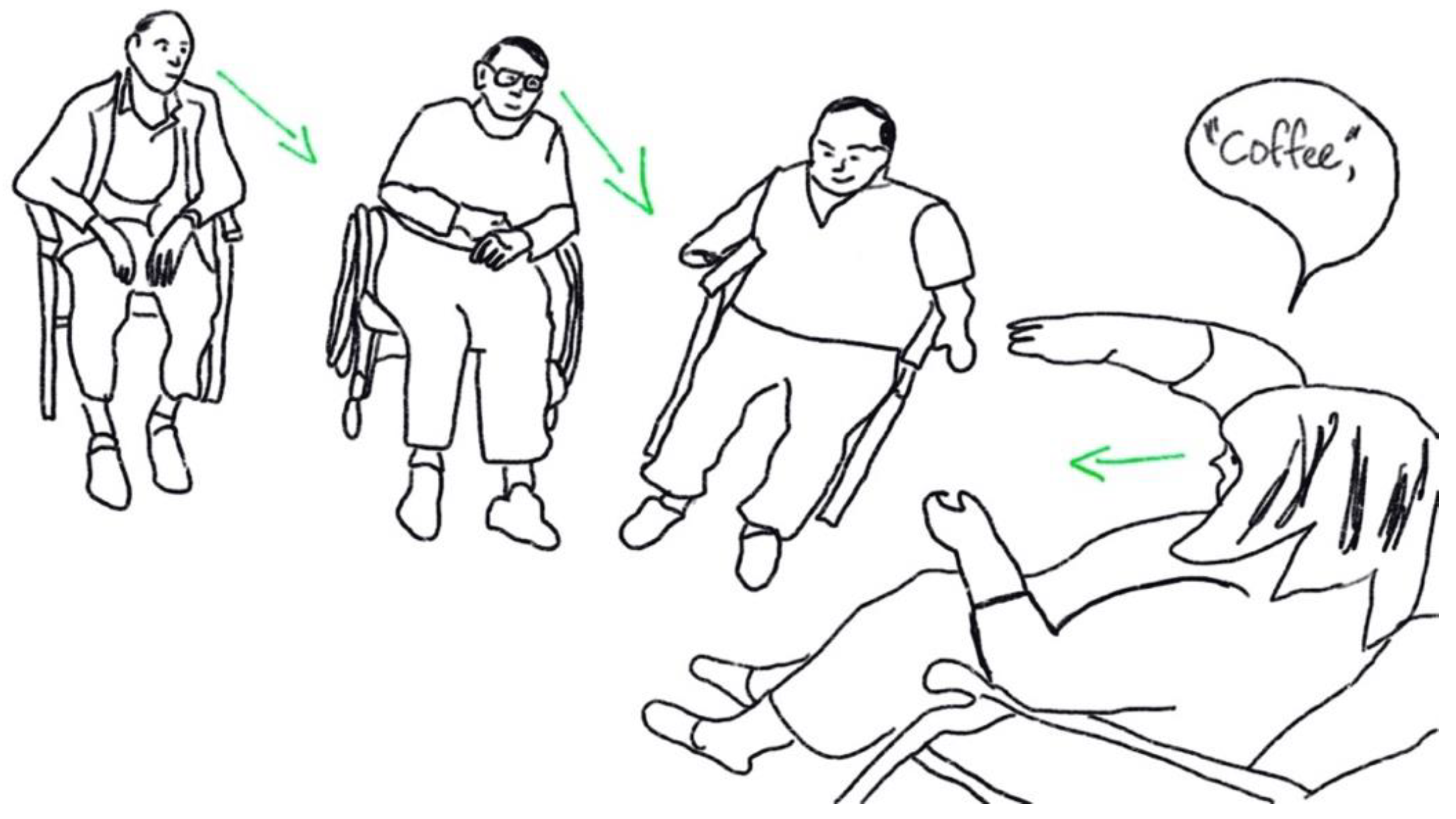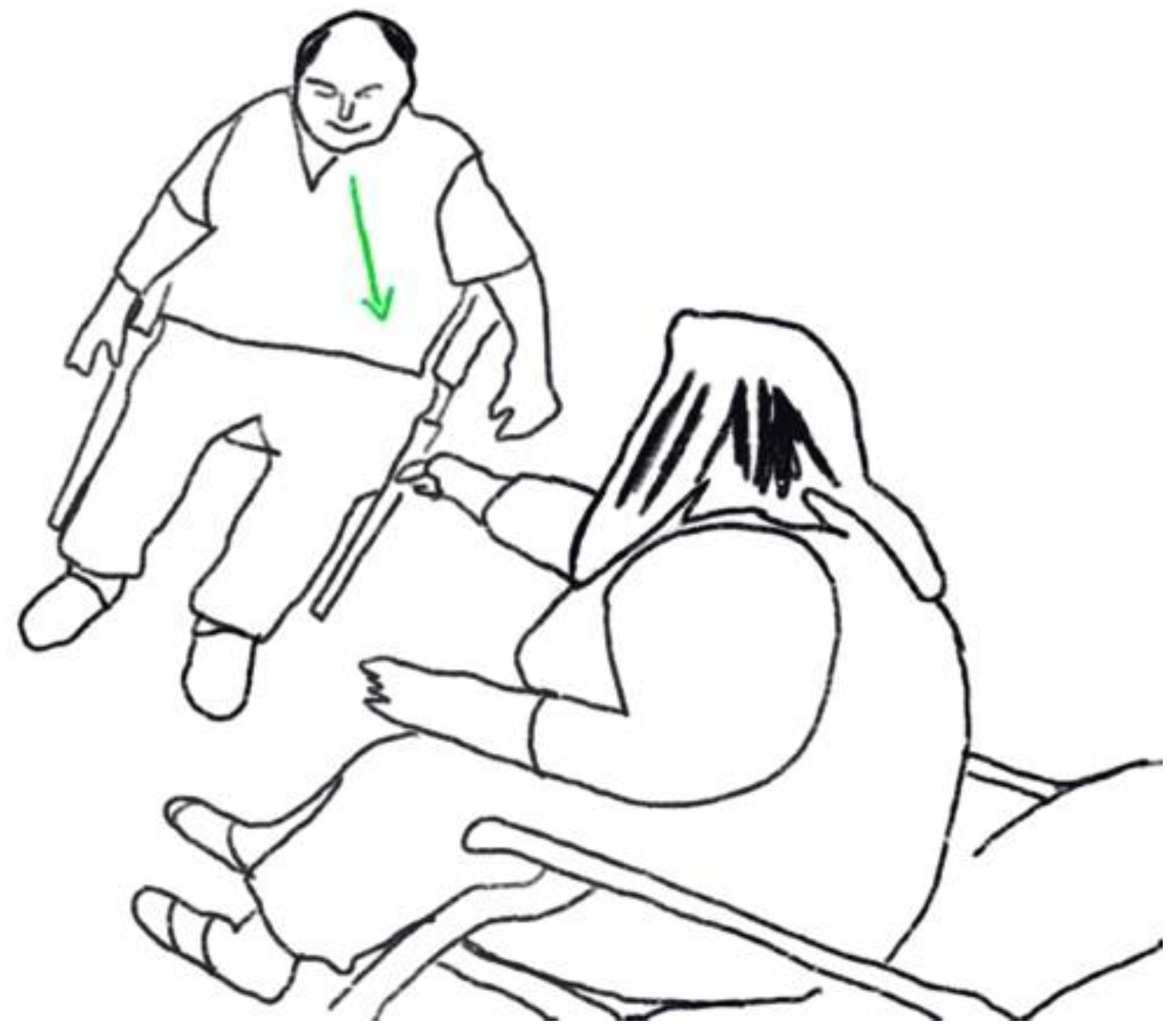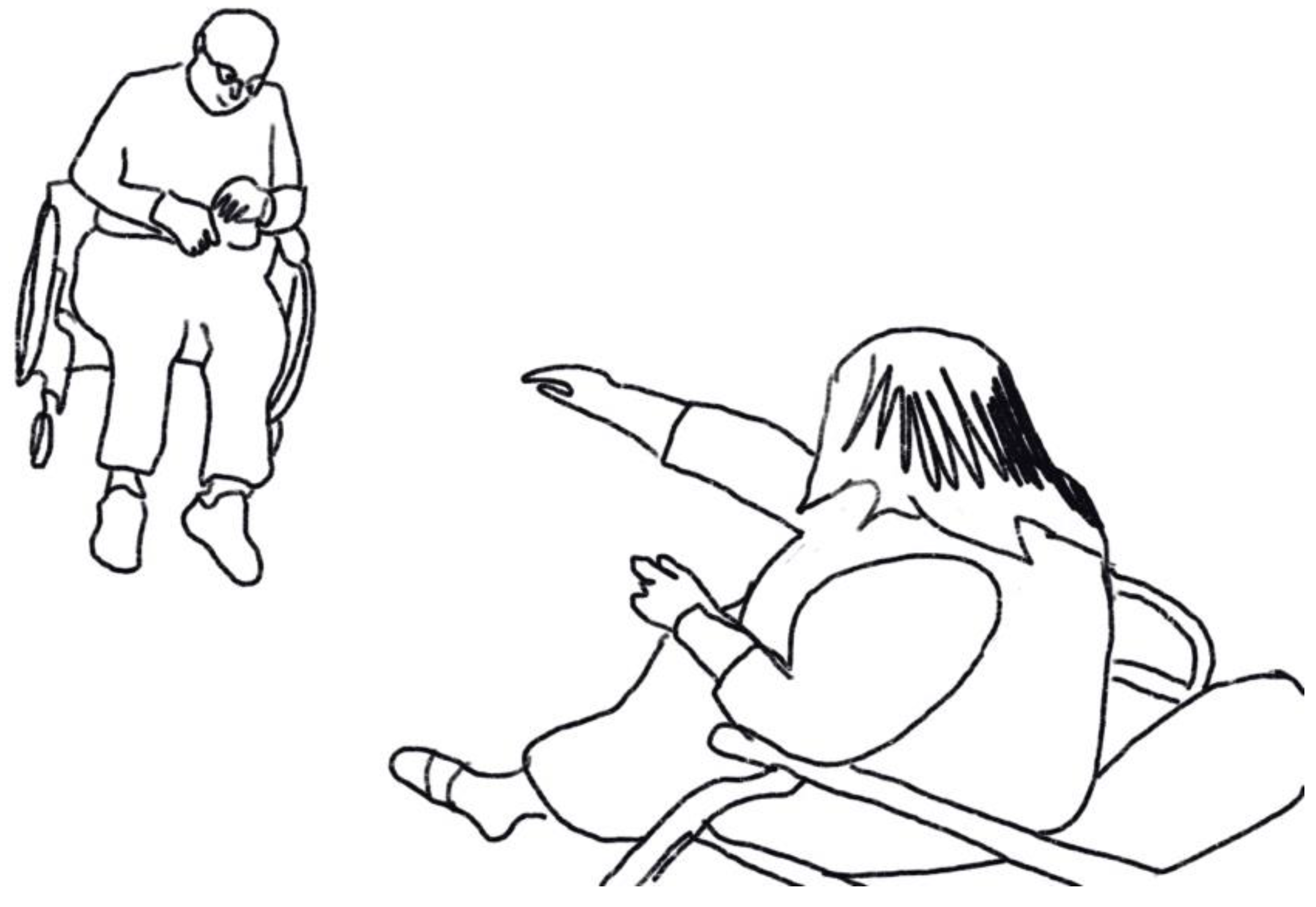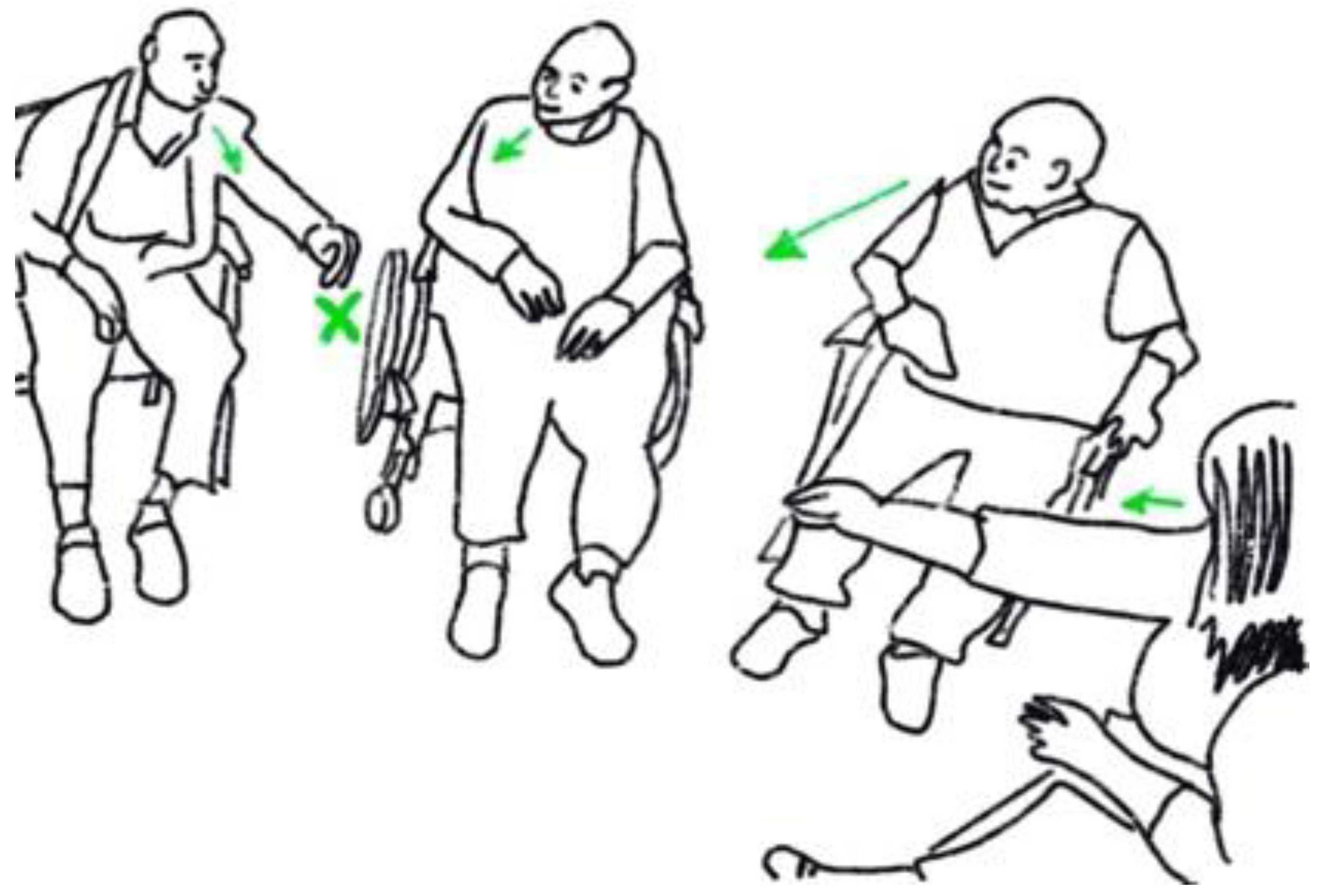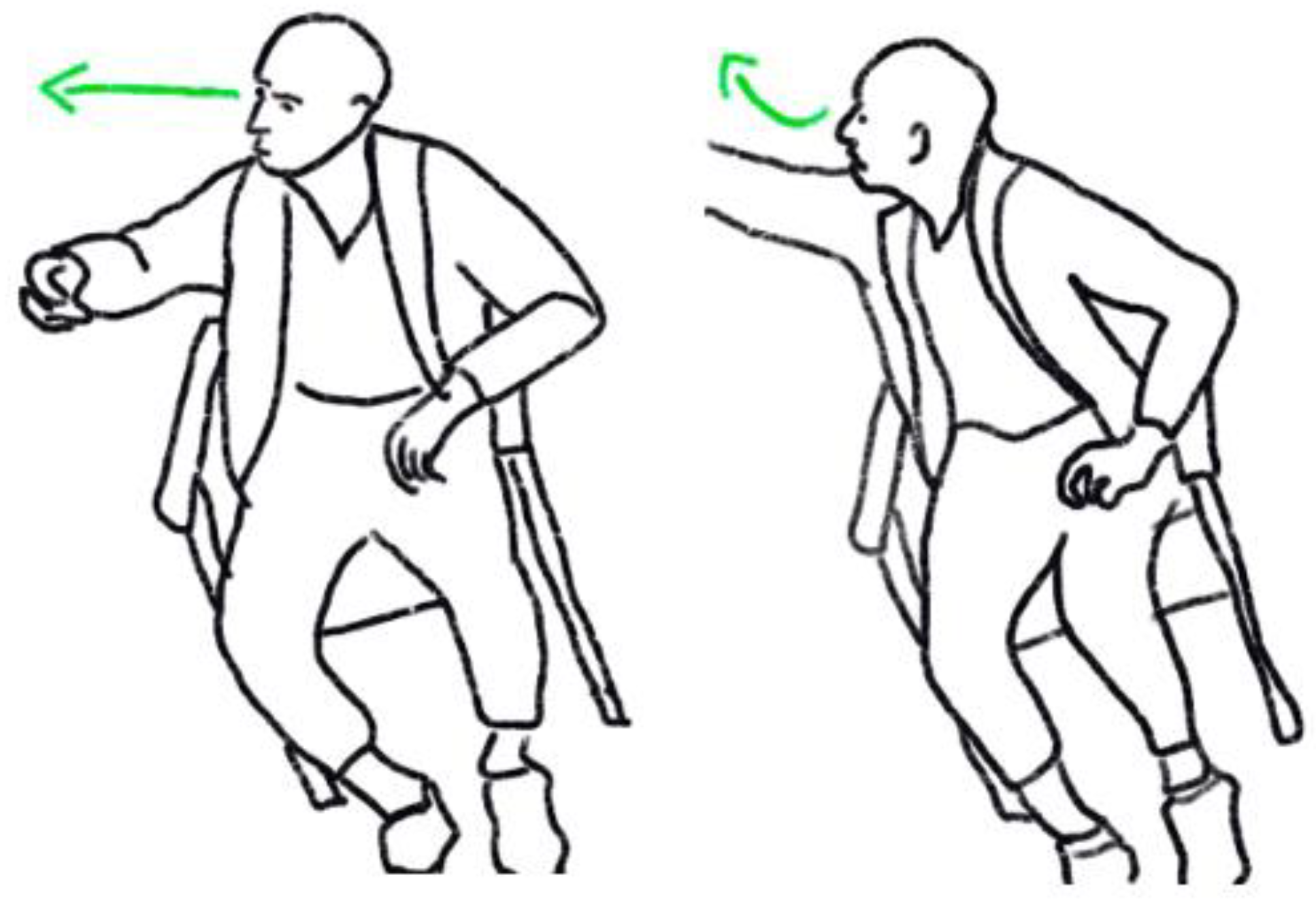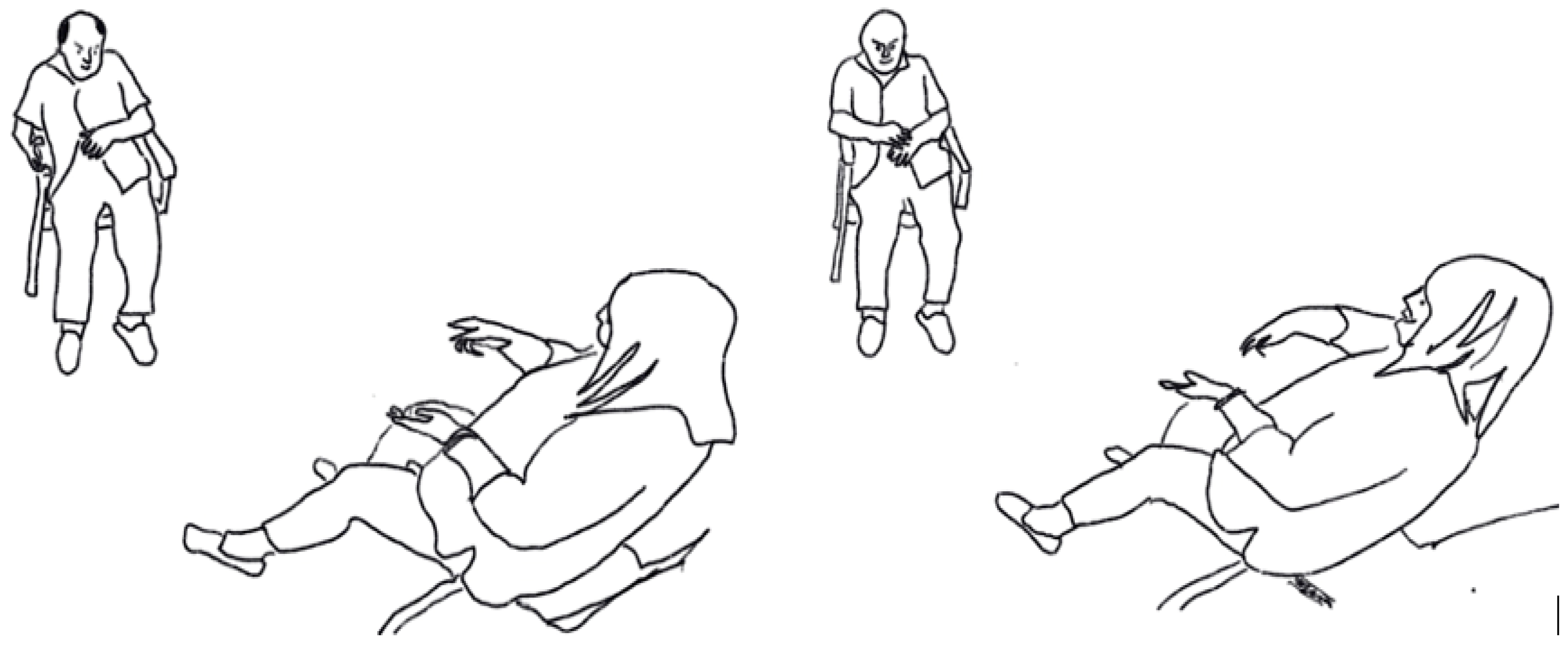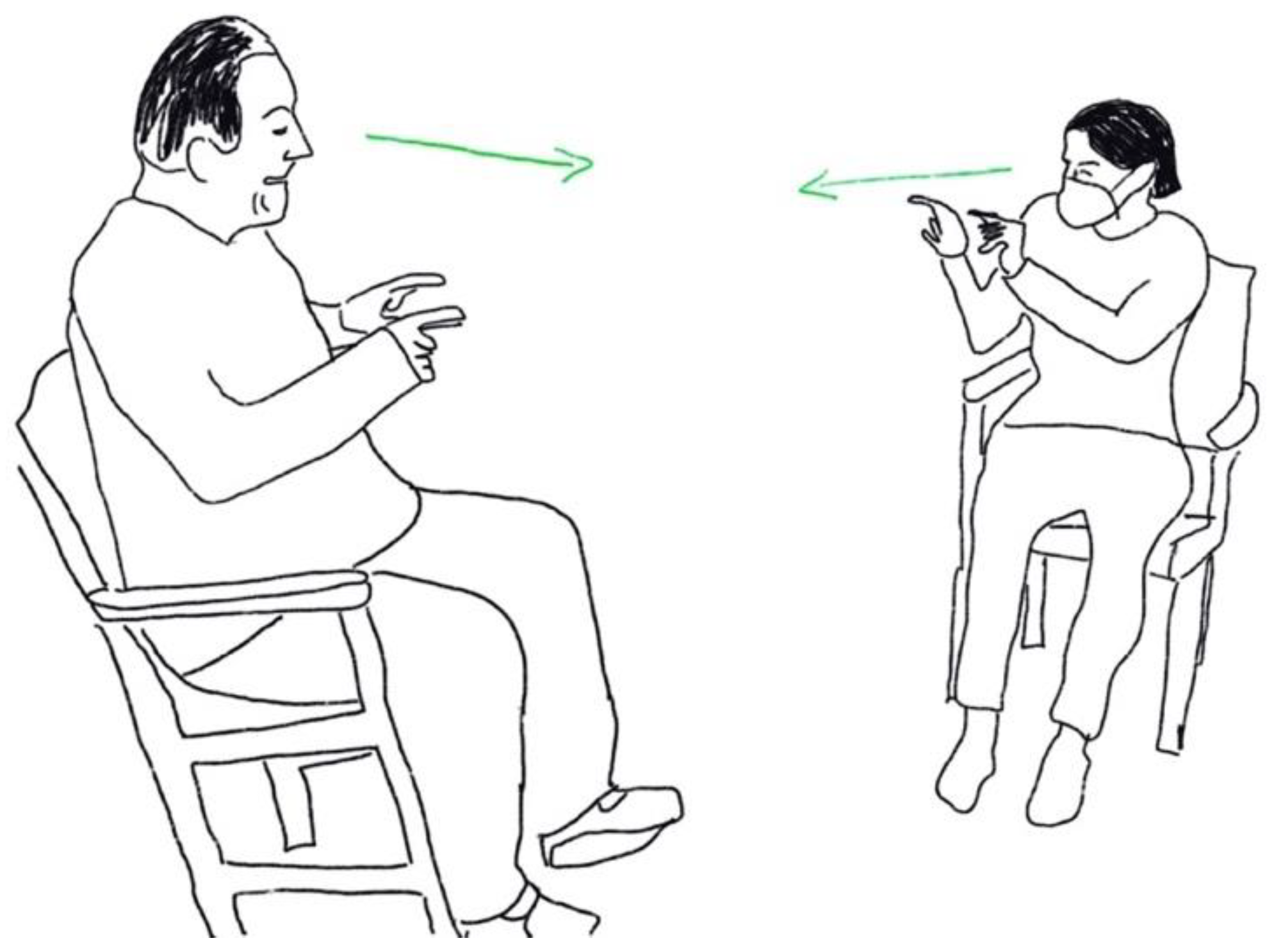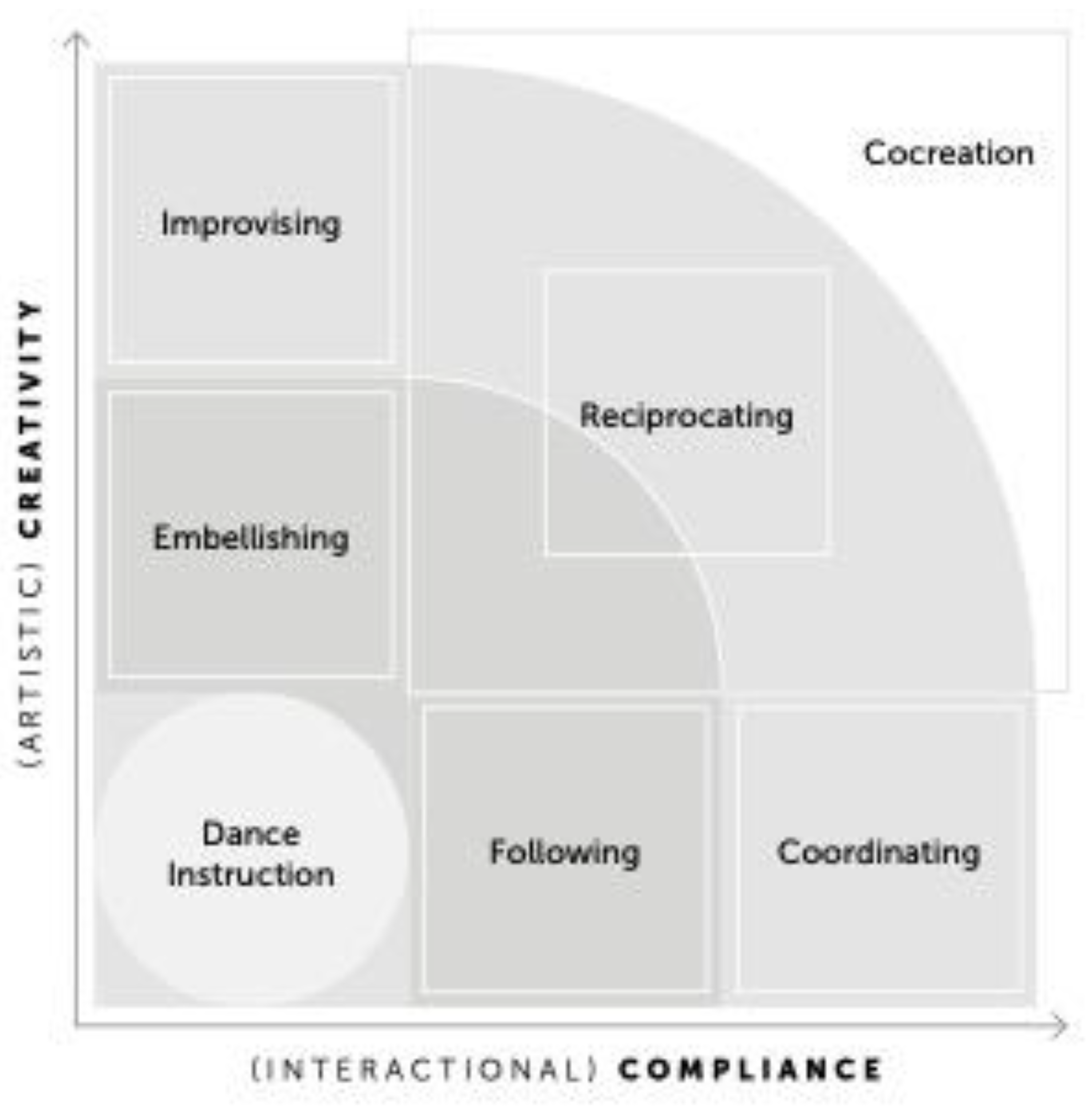Below, we present five multimodal transcripts that illustrate how participants, including resident older adults, PLWD, and carers (staff/facilitators), respond to the on-screen instruction (OSI) of the seated Sharing Dance program. In each of the settings shown, participants are seated in chairs facing a TV monitor, where the program plays. The OSI is prerecorded and streamed from a remote location, with her chair facing the camera and her gaze to the lens so that her instructions seem directed to the viewer. The facilitator (either the author/researcher or a staff member) is seated close to the screen. As the dance program plays on the screen for participants, the OSI first demonstrates the upcoming movements with verbal descriptions and then cues the music and participants to join with her as she repeats the dances, providing verbal directives with accompanying embodied demonstrations. Each of the dances below (other than the warm-up in the first example) is designed to depict scenarios (i.e., a Broadway chorus line; under the sea; a coffee break; and a trip to the art gallery). The first two examples show how participants’ responses to creative direction embody mimicable shapes as directed. In the first, an individual complies with the OSI in a classical (albeit embodied) adjacency pair completion. In the second, a series of adjacency pairs are coordinated in sequential order by a copresent facilitator. The third and fourth examples highlight how participants respond creatively in their instructed actions: one with embellishing flourishes in response to the OSI, and the other improvising according to ability in response to the copresent facilitator. In the fifth example, reciprocal cocreativity is highlighted in a sequence of contingent responses between a participant and a copresent facilitator, as initiated by the OSI. In all cases, instructed action comprises multimodal directives (verbal and embodied) in demonstrations for participants to follow.
3.1. Getting Warmed Up: Following the Leader with Matching Movements
In the first excerpt (1), we analyze how a participant follows the OSI on cue, with matching movements, bodily quoting the OSI (
Keevallik 2010) in response to multimodal directives, in coordination with temporal rhythm of the music. As this excerpt begins, a previous sequence of dance movements has finished and is to be repeated. The participant, Anita, is seated among other participants in a side-by-side formation, with her chair facing the screen (shown in rectangular boundary box in
Figure 1). Anita follows the directions and matches the knee-tapping movements of the OSI in time, joining together with the OSI as she continuously maintains the rhythm of the music.
| (1) OSI: On-screen instructor (¶), Anita(ani): dancer PLWD (Δ), Music (mus) ♫ |
| |
| 1 OSI | one more time here we go ¶♫1Δtapping, (0.1)# |
| a mus | >>piano plays ♫1->> |
| b osi | >>gz camera ¶taps hands on knees ((with music))->> |
| c ani | >>gz screen Δtaps knees ((in same time)->> |
| d fig | #Figure 1 |
Prior to the start of the transcript (1a), the music set the temporal, rhythmic structure for the activity in a predictable, recognizable pattern, made relevant by the OSI, who was oriented to the beat in how she timed her multimodal instruction. The OSI began with a verbal directive that indicated an upcoming action, “one more time,” involving “we,” with a cue of when to start (“go”) and what to do: “one more time, here we go tapping” (1a). The OSI’s embodied demonstration of knee-tapping began on the first beat immediately following the verbal directive “go” (1b) that projected the embodied response of the ongoing repeated action “one more time” (see
Figure 1). Anita responded in turn, on the beat in the relevant place in the sequence (1c), tapping her knees at the same time as the OSI, with both continuing the tapping in keeping with the music to the end of the sequence.
Within the embodied conversation of the dance class, a bodily move can be equated to a verbal utterance (see
Keevallik 2010). As the OSI directed an embodied response from the dancer, this can be seen as the first part of the classic adjacency pair in conversation analysis (
Sacks et al. 1974). When Anita responded by following along with the instruction, in time, with matching movements bodily quoting the OSI (
Keevallik 2010), the second part of the pair was in compliance with the initiated first part, and completion of the pair. The achievement of the instructed action was directed by the prerecorded OSI using verbal and embodied resources in coordination with the predictable external musical rhythm (see
Albert 2015). Anita’s subsequent embodied response displayed her understanding of not only what was expected but also how to complete the action in time as the moment progressed, by tapping her knees as demonstrated, immediately upon the beat following the directive “go.”
3.2. A Sequence of Depictive Gestures in Turn: Coordinating a Pretend Coffee Break
In the next excerpt (2), we illustrate how coparticipants orient to each other sequentially within a timed musical structure in response to on-screen instructions (OSIs) and as they are repeated by a copresent facilitator. Three participants, Dancer 1, Dancer 2, and Dancer 3, are seated with their chairs facing the screen, and a facilitator sits beneath the screen, facing the participants (see
Figure 2). The OSI provides an embodied demonstration of a coffee-pouring and -sharing scenario within a musical structure of eight beats. The coffee pouring takes four beats, and the sharing takes four beats (two beats to reach toward a participant (to hand them a cup) and two beats to return to home position). The eight beats are shown in the transcript as numbered musical notes (♫1, ♫2, etc.). Example (2), below, begins as music playing leads up to the first measure (counted and shown as ♫5, ♫6, ♫7, and ♫8). During the musical lead in, the OSI cues the timing of the projected instructed action, “pour yourself some coffee.” The facilitator then “takes the lead” and pours coffee for the three dancers, who each respond in turn.
| (2) OSI: On-screen instructor ¶, Fac: Facilitator (staff) +, Dancers 1–3, Da1 Δ (PLWD), Da2©, Da3 (PLWD) ø |
| |
| 1 OSI | ¶ ♫5 Pour yourself♫6 some coffee,♫7 |
| a Osi | ¶ ((mimes pouring))-> |
| P Mus | >>♫piano plays 4/4time ((5,6,7,))♫->> |
| | |
| 2 Fac | ♫8¶(0.2)♫1+Coffee,# (0.3) ♫2 |
| p Mus | ♫ piano plays 2 beats ((1,2))♫ |
| a Osi | ->¶ |
| a Fac | +((mimes pouring acc to demo))-> |
| b Fac | ->gz own hands |
| c Da1 | ->gz Fac hands |
| d Da2 | ->gz Fac hands |
| e Da3 | ->gz Fac hands |
| f fig | #Figure 2 |
In compliance with the OSI’s directive (1), the facilitator depicts with her hands the matching shape of pouring a coffee (2a) and verbalizes “coffee” (2) within the timed structure of four beats (2P—3b). Her gaze is on the shape as she creates it with her own hands (2b) (see
Figure 2). The dancers each orient to her movements with his or her gaze, focused on her hands (2d–f).
| 3 OSI | Give¶♫3 it to a friend, +¶♫4 |
| P mus | ♫piano plays 2 beats ((3,4)) ----------♫ |
| a Osi | ¶♫ reaches to camera, flicks wrist ¶♫ ((to place coffee)) |
| b Fac | ----------------------------------------->+ |
| | |
| 4 FAC | (0.2)+for you,♫5 (0.1)+(0.6)♫6Δ + #♫7 (0.6)+(0.6) +♫8 |
| P Mus | ♫ piano plays 4 beats ((5,6,7,8))------------♫ |
| a Fac | +reaches ♫to Da1 +puts ♫cup btwn+ #♫,,,,,,,+reachback+♫ |
| b Da1 | Δ turns head, opens hands |
| | gz cup spot-> |
| c fig | #Figure 3 |
Continuing with the sequence in time to the music, the OSI initiates the next directive, “give it to a friend,” just in time to finish on the fourth beat (3), when the F completes the pouring gesture (3b). Next, on beat five (4), the facilitator reaches toward and “hands” the imaginary coffee to Dancer 1 with a verbal offer, “for you” (4). With a wrist motion, she “places the coffee” (4a) in the space between them on beat seven, reaching back by beat eight. Dancer 1′s gaze follows the facilitator’s hand and remains focused on the spot where the cup was placed (4b) (see
Figure 3).
| 5 | (0.1)+♫1Δ ♫2 ♫3 (1.6) ♫4+ |
| P Mus | ♫piano plays 4beats ((1,2,3,4))♫ |
| a Fac | +mimes pouring--------------------+ |
| b Da1 | Δgz Fac hands-> |
| | |
| 6 FAC | For +♫5you, hehehe©#+ (0.6) © +♫6 +(0.6)Δ (0.1) |
| P mus | ♫ piano plays 2 beats((1,2))----♫ |
| a Fac | + reaches to Da2+puts cup btwn +,,,+reaches back-> |
| b Da2 | ©#nods head© |
| c Da1 | Δgz coffee |
| d fig | #Figure 4 |
Starting again on beat one of the next musical measure and over the course of four beats, (5) the facilitator repeats the coffee-pouring motion (5a) and verbalization “for you” (6) that she did in her first turn (2,2a); again, similarly to her previous turn (4a), the OSI reaches with the coffee on beat five, but this time to Dancer 2, (6a) who sits next to Dancer 1. Dancer 1 shifts his gaze to the spot where the coffee was placed for Dancer 2. Dancer 2 acknowledges receipt of the coffee with a head nod (6b) toward where the coffee was placed (see
Figure 4).
On beat seven, Dancer 2 looks down at his hands (7a) and shapes them as if around an imaginary cup (7b) (see
Figure 5). Then, within the next and eighth beat, Dancer 2 breaks his hands apart (making the cup disappear) and looks up (8a) with an eye roll, smiling (8b) (see
Figure 5), making visible to coparticipants his stance on the creative practice, within the structure of the musical measure.
| 9 FAC | ♫1+hehehe©(0.6)Δ (0.6) ♫4 |
| P Mus | ♫piano plays 4beats ((1,2,3,4) ♫ |
| a Fac | +mimes pouring coffee-> |
| b Da2 | ©gz Fac, smiles-> |
| c Da1 | Δgz dancer3-> |
| | |
| 10 | ♫5+(0.6)©Δ# +ø (0.3) ♫6+ (0.3)ø+ (0.3) ø+♫7 |
| P mus | ♫piano plays 3 beats ((1,2,3)) ------------------------♫->> |
| a Fac | +reaches#to Da3+ places cup +,,,,,,,+reaches back + |
| b Da3 | øreaches coffee,,,,,,øcloses thumb ø |
| c Da2 | ->©gz Da3 hand-> |
| d Da1 | ->Δgz Da3 hand-> |
| e fig | #Figure 5 |
On the first beat of the next musical measure, the facilitator laughed (9) in response to Dancer 2′s stance display. Dancer 2 shifted his gaze to the facilitator (9b) and smiled. At the same time, within the four-count measure, the facilitator repeated the mimed pouring of coffee (9a). Halfway through this measure, before the facilitator was finished pouring, Dancer 1 oriented his gaze to Dancer 3, displaying understanding of whose turn was projected to receive the next cup. In the same pattern as the previous two turns, on the fifth beat (10), the facilitator reached toward the next seated participant, Dancer 3 (10a). Dancer 3 reached toward the placement of the imaginary coffee and then closed his thumb as if around an invisible handle on the seventh beat (10b). Dancers 2 and 1 were both focused with their gaze at the space where the cup was being shaped (10c,d). At this point, all four of the coparticipants were oriented toward the imaginary cup (see
Figure 6).
Over the course of the coffee-time scenario, the coparticipants shared a joint focus of attention on the facilitator, and each displayed an understanding of being handed something in their turn, as well as an understanding of the next participant’s upcoming turn. The facilitator repeated the pattern of the movement sequences in time with the rhythm established by the OSI for a total of three times. In each iteration, the OSI poured the coffee from beats one to four, and then on beats five to six, she handed it to each participant in turn. On beat seven, in all three instances, the dancers embodied receipt of the facilitator’s offered object within the timed structure of the musical rhythm. Each dancer’s embodied response was individually enacted. Dancer 1 opened his hands (4b), Dancer 2 brought his hands together in a shape around the invisible object, and Dancer 3 reached and closed his thumb. Each performed their receipt on the same seventh beat in the musical structure in a coordinated, taking turns. While the OSI initiated the embodied directive to “pour yourself some coffee” (1) and “give it to a friend” (3), each participant, in coordination with the facilitator, was given his moment in a measured musical beat to create a signature move in response. By the eighth count of each iteration of the coffee-pouring and -sharing sequence, the group focus of the movement shifted in orientation to the next dancer in turn. While initiated by the OSI, then led by the facilitator, the rhythm of the music provided an external interactional resource in a predictable structure (
Albert 2015) with which each individual aligned in sequence. By the end of the sequence, each dancer had contributed a unique movement to the creation of a shared dance, which was led by the facilitator, in alignment with the ongoing instructed action (
Stivers 2008). Coparticipants, in turn, each displayed alignment with the musical beat as the facilitator-initiated responses in a chain of sequentially contingent actions (
Schegloff 2007). The creativity afforded to each individual was structured yet improvised according to individual interpretation and ability. Their responses were compliant in aligning with the predictable structure of the turns in sequence and creative in their individual expressions of receiving their “coffees” in turn.
In the two examples above, participants used bodily quoting in alignment with sequential and musical structures to achieve instructed actions. Participants’ responses to creative direction were achieved in interactional compliance with matching movements. In the first, Anita complied with the OSI in a classical (albeit embodied) adjacency pair completion. In the second, a series of embodied adjacency pairs were coordinated in sequential order by a copresent facilitator. In both examples, the temporal structure of the music provided a resource to cue participants as to when to move. In the second example, the facilitator responded to the OSI’s multimodal directive on cue to the beat, and repetitively, in quoting the OSI’s bodily movements (
Keevallik 2010). In sustaining the rhythm of the OSI choreography, the facilitator used the music as a resource to organize the turn-taking sequence that projected a visible predictability of upcoming action for her coparticipants. The inherent artistic creativity of the dance was realized in both cases through participants’ compliant turn-taking responses to the instructions.
3.3. Being Dramatic on Broadway: Embellishing Flourishes
In the next example, we analyze how a participant creatively embellished the instructed movements in response to directives. In the transcript (3) below, Dan is seated facing the screen. The OSI demonstrates the Broadway chorus line choreography in which she depicts that she is clasping a top hat in her hands, held at the torso. The OSI directs participants to depict and present their own imaginary hats by pushing them out (reaching) and bringing them back in. Dan complies by following the instructions and adding his own embellishments.
| (3) OSI: On-screen instructor (¶), Dan: dancer PLWD (Δ) |
| |
| 1 OSI | and ¶re:ach, (0.3)Δ and (0.2) ¶in,(0.3)Δ ¶ Δ |
| a Osi | ¶pushes hands out ¶pulls hands in ¶ |
| b Dan | >>gz screen Δpushes hands right---Δpulls hands inΔ |
| | |
| 2 OSI | and then can you (0.3) ¶↑throw it away ¶ |
| a Osi | ¶flicks wrist up¶ |
| | |
| 3 | (0.3)Δ(0.3) # Δ |
| a Dan | Δflicks hand to side Δ |
| b Dan | ->gz imaginary hat# |
| c fig | #Figure 7 |
| | |
| 4 OSI | ↑nice and dramatic Δ like on Broadway# |
| a Dan | Δ suspends raised arm, turns torso-> |
| b Dan | ->gz follows hat above arm and R-> |
| c fig | #Figure 7 |
From the beginning of the sequence, a compliant embodied response was projected by multimodal instructions composed of verbal directives—“and reach” (1), followed by “and then can you throw it away” (2)—accompanied by an embodied demonstration of reaching (1a) and then flicking wrists (2a) movements by the OSI. Dan showed his understanding of what was expected by matching his arm movements to those of the OSI (1b). When Dan responded with the compliant embodied flick, he additionally moved his gaze to where the hat would be thrown away (3a). This extension of his gaze was not an instructed action but an embellishment of his own. Next, the OSI verbally directed the movement to be “nice and dramatic” (4). In response, Dan extended his arm and gaze, twisting his body to watch the hat fly away. Within the sequence, Dan complied with the directed action, created his own flourish, and embellished it on cue according to what was directed, “to be dramatic.” Within the sequence, Dan displayed his unique expression of individual creativity. His emphasized embodiment made relevant the OSI’s directive to be dramatic and displayed his understanding of what was expected of him in his individual performance of throwing the hat (4b) (see
Figure 7). He was compliant in his response to the instruction and creative in his individual interpretation. As
Kontos et al. (
2020a) pointed out, the creative flourish is often associated with the accomplished artist; this example showcases a person living with dementia performing an artistic embellishment with his own signature. Our analysis illustrated how this was achieved in response to multimodal directives in the creative instruction.
3.4. Individual Expression: Improvising Seaweed Movements
In the next example (4), we focus our analysis on how one participant improvises an unplanned movement of his own, within the structure of the activity, in response to the copresent facilitator’s encouragement. The participant, George, is part of a group of seated dancers facing the screen. A facilitator (staff) sits below the screen facing the dancers and demonstrates the movements in copresence. The sequence begins as a dance session is in progress and the on-screen instructor (OSI) has directed participants to move their arms and upper body like seaweed. The facilitator encourages George to comply with the instructed movements and provides an embodied demonstration similar to the OSI. George complies with the instructed movement by copying the facilitator’s movements at first. Then, he deviates from the demonstration and moves his hands his own way.
| (4) OSI: On-screen instructor ¶, FAC: facilitator +, Dancer George (Geo) ø (PLWD) |
| |
| 1 OSI | Now ¶we have our seaweed, |
| a Osi | ¶sways torso, twists arms upward->> |
| | |
| 2 FAC | (0.2) O:ohh+seaweed (1.0) C’mon George be some seaweed |
| a | >>gz screen+gz George |
| b | +sways torso, twists arms upward-> |
| | |
| 3 FAC | (1.0)øSome seawee=ø =thats# it(.)good one George(.)good one(.) |
| a Geo | øgz Fac ø sways#torso, swings arms to sides-> |
| b fig | #Figure 8 |
| | |
| 4 GEO | (1.0) ø(0.3)+(I can say I’m just doing this)# ( )follow yours |
| | |
| a Geo | ->øwrings hands together->> # |
| a Geo | gz hands |
| b fig | #Figure 8 |
| c Fac | +stands, leans into George-> |
| | |
| 5 FAC | You just can’t do it +well you do what +your body can do, right, |
| a | ->+sits back in seat+ |
Continuing an ongoing instruction sequence, the OSI gave the verbal directive, “now we have our seaweed” (1), with an embodied demonstration, twisting her arms in upward motions (1a), comprising the multimodal instruction. This projected a relevant next in the dance sequence. “Now” provided the cue in the timing, along with the embodied demonstration of what “we” the participants following were to be doing in this moment, “our seaweed.” Neither did the depictive gesture nor the verbal directive alone represent a recognizable instruction; together, they constituted the formation of the action (
Lilja and Piirainen-Marsh 2022). The response of the facilitator produced the instructed action (
Garfinkel 2002) in her compliant embodied replication of moving and swaying her arms similarly to the OSI (2a). Her verbal “o:ooh” (2) produced an affiliative stance display that positively endorsed the movement, while her embodiment of seaweed aligned with the structure of the ongoing activity (
Stivers 2008). The facilitator reformulated the OSI directive as an invitation with a summons, “C’mon George, be some seaweed,” as she quoted the OSI depictive gesture of seaweed (2). When George responded to the summons with shifting gaze, matching the facilitator’s movements (3a), he made the facilitator’s reformulated instruction understandable and aligned with her directive in compliance (see
Figure 8). After a beat, George changed his hand movements to his own unique wringing movements, not demonstrated by the OSI or the facilitator (4a) (see
Figure 8). He accounted for this verbally, with a deictic reference, “I’m just going like this,” and his gaze pointed toward his hands (4a). The facilitator responded to George with an affirmation of his approach, “well you do what you can, right,” (5) showing agreement with George’s change of movement and affiliation that his action was right based on his physical ability.
In breaking away from following the lead of the facilitator and improvising his own movement, George initiated a response from the facilitator (5), who complied with affiliating agreement to his approach. As
Kontos et al. (
2020b) highlighted, creative action can emerge from practical involvement in a task, not only as an individual cognitive trait. This example illustrated George’s improvisation in response to the facilitator’s creative direction to “be some seaweed” in relation to what he had to work with using his own hands. George’s verbal turn reformulated his ongoing action as self-motivated rather than according to the facilitator’s multimodal directive. In this way, his accounting for his incipient compliance (see
Kent 2012 allowed him to maintain autonomy of his own conduct according to his ability. George’s account of his interpretation can be analyzed as a prosocial action in explaining his potentially misaligning move (
Schegloff 2007), afforded in interaction by the copresence of the facilitator. In this example, the copresent facilitator’s affiliating stance afforded the opportunity for George’s improvised movement to be sanctioned as allowable within the parameters of the activity.
3.5. When Pointillism Becomes Pointing at Each Other: Cocreating Embodied Reciprocity
Our final example showcases how a facilitator and participant reciprocate and build upon each other’s movements and affective stances in the cocreation of their own dance in response to instructions. In the excerpt (5) below, the copresent facilitator is seated in a circle, along with residents and staff, oriented toward the screen, where the prerecorded dance is in progress. The scenario is a trip to the art gallery, and the movements represent different techniques of painting. Where the transcript begins below (5), the OSI directs dancers through the pointillism technique, depicting repetitive pointing gestures into the air. The facilitator is pointing into the air, as instructed by the OSI, while monitoring participants. One of the dancers, Joe, watches the facilitator before joining in with matching his movements to the facilitator’s. The facilitator sees Joe watching her and points toward him. What follows is a reciprocal exchange of movements that lead to the dyadic dance cocreated by Joe and the facilitator.
| (5) OSI: On-screen instructor ¶, Fac: Facilitator (researcher) +, Joe: Dancer (PLWD) Δ |
| |
| 1 OSI | and now we ¶make our fine details+ |
| a Osi | ¶points fingers repeatedly->> |
| b Fac | +points fingers repeatedly->> |
| | |
| 2 | (1.0)+ (0.3) + Δ (1.3) + |
| a Fac | +gz Joe +raises eyebrows +gz own fingers-> |
| b Joe | gz Fac->> Δlifts hands-> |
| | |
| 3 | (1.0)Δ(0.6)+*(1.0) + |
| a Joe | ->Δ pokes fingers into air repeatedly toward Fac->> |
| b Fac | ->+gz Joe’s fingers, raises eyebrows+ |
| c Fac | *nods, turns torso and pointing toward Joe->> |
| | |
| 4 Fac | + (1.8) Δ(1.0) hehehe# + |
| a Fac | +gz Joe, shrugs shoulders toward Joe+ |
| b Joe | Δsmiles at Fac, shakes shoulder in silent laugh->> |
| c fig | #Figure 9 |
From the beginning of the sequence, an instructed action was projected in response to the OSI. Following the OSI’s verbal directive, “now we make our fine details,” accompanied by embodied demonstration of pointing fingers (1,1a), the facilitator made repeated pointing gestures (1b), demonstrating the OSI’s embodied directive (1,1a) as Joe watched (1b). The facilitator raised her eyebrows at Joe and, using her gaze, shifted her focus to her pointing fingers (2a). When Joe started to join the action with his own pointing fingers, (3a) the facilitator returned her gaze to Joe and raised her eyebrows in his direction (3b), turning her movements toward him in alignment with his joining the activity. The facilitator’s shrug and laughter directed toward Joe (4) displayed an affective stance to which Joe’s contingent response was an affiliative smile. The result was a collaborative achievement of joining together in a cocreated response to instructions in a shared moment of laughter. Their shared moment of pointing at each other was collaboratively achieved in a sequencing chain, in reciprocity. The resulting escalation unfolded as the two oriented to each other’s movements and responded in turn to their affiliative stance displays, in the service of experience sharing (
Stevanovic and Peräkylä 2015). In their compliance within a chain of sequentially and reciprocally contingent actions, as initially directed by the OSI, they cocreated their own shared work of art—in an intercorporeality that neither could have accomplished without the other.
In summarizing the five excerpts we presented above, each of the examples illustrated sequences initiated by an onscreen instructor, followed by variably compliant responses and different types of creativity. We organize these below on axes of compliance and creativity to demonstrate how they are related to the dance instruction.
Anita’s warm-up was a precise following in the matching movements of instructed action, demonstrating a prosocial second pair part embodied by the participant in response to the OSI. The coffee break was similarly prosocial, with the facilitator taking the lead and participants coordinating their matching, yet individual movements in a turn-taking structure (
Schegloff 2007). Both of these examples were in alignment with the activity structure as instructed by the OSI and facilitated by copresent staff. The first was compliant with the OSI, and the second was compliant with the copresent facilitator, increasing the complexity and cooperative nature of the social interaction.
The next two examples highlight the nature of the creativity in relation to the dance activity. Dan complied with OSI directions, embellishing flourishes—as instructed and of his own accord, given space in the sequence to do so. Dan was compliant similarly to Anita in response to the OSI and added a level of creativity in his embodied self-embellishments, exaggerating dramatically “in the Broadway chorus line.” George went even further in his artistic expression in improvising his seaweed movements, adding a creative touch and an interactional turn to the sequence in response to the facilitator.
In the final example of the pointillism dance, a facilitator and participant each responded to each other in reciprocated instructed movements in what became a pointing at each other in their own shared creation of a pointing dance. Both creative and compliant, this example illustrated how the dance instructions were achieved in a sequential chain and built reciprocally, as each contingently responded to each other in alignment with the structure of the activity and in affiliation with each others’ stance displays (
Stivers 2008).
We organized each of the examples in a figure (
Figure 10) below that illustrates the different types of creativity (in the activity of the dance) and compliance (in the instructed actions). Along the axis of creativity are the actions of embellishments that built upon the dance instruction, first in embellishing and then in improvising. Along the axis of compliance are the actions that increase in complexity of coordination with coparticipants, from following OSI movements as an individual to following in sequential turn-taking. Somewhere in between the intersections of artistic creativity and interactional compliance, cocreativity is realized, as indicated in our final example (see
Figure 10).

